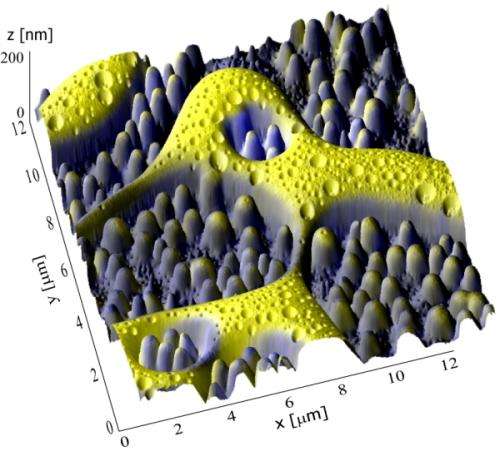Two become one with the 3-D NanoChemiscope

The 3D NanoChemiscope is a miracle of state-of-the-art analysis technology. As a further development of well-known microscopic and mass spectroscopic methods, it maps the physical and chemical surfaces of materials down to the atomic level. This instrument, which is unique in the world, not only delivers high-definition images; it also knows what it is "seeing".
What do a penguin and the surface of a solar cell have in common? Not a lot concedes Empa physicist Laetitia Bernard. Yet she must have smiled when, while processing an image of a polymer blend required to produce a new type of organic solar cell, at a certain point she could make out more and more clearly the outline of a penguin. A small detail in the complex world of high-performance microscopy.
The 3D NanoChemiscope, which was developed at Empa, not only maps samples with nanometre precision, but for the first time can also provide precise information about which chemical elements are arranged where in a sample. This enables both mechanical properties, such as hardness, elasticity or friction, and chemical properties of surfaces to be determined simultaneously in three dimensions. In the case of the "penguin" image, this means that the 3D NanoChemiscope not only captures the outline of the "penguin", but also detects which polymers are located at its "beak", at its "eye" and "around" it. Using this analysis technique, the solar cell researchers are able to efficiently control the mechanisms of their materials and adapt the composition or concentration of their polymer blend accordingly. This enables new structures and therefore leads to better performances of the solar cell to be created.

Scanning force microscope and high-end mass spectrometer
This analysis is made possible by the 3D NanoChemiscope, which combines two previously independent techniques. The scanning force microscope (SFM) scans the surface with an ultra-fine tip, while the time-of-flight secondary ion mass spectrometer (ToF-SIMS) determines the material composition of the first surface mono-layer by "shooting" metallic ions at it.
Up to now, in order to study both the chemical and physical properties of surfaces, it was necessary to analyse the sample in two different instruments. However, when transporting the sample from one instrument to the other, there was always a danger of contamination or oxidation. In addition, it was practically impossible to find the exact location scanned by the SFM again. What, therefore, could be more appropriate than to "combine" the two instruments? In a four-year project sponsored by the EU, project leader Laetitia Bernard, together with Empa researchers and partners from academia and industry, has carried out meticulous work to develop a new instrument in which an SFM and a ToF-SIMS are placed in an ultra-high vacuum chamber as near to each other as possible.
The microscope experts have also equipped the 3D NanoChemiscope with a novel transport system developed in-house, which uses piezomotors to move the sample gently back and forth on tracks coated with a diamond-like carbon layer (DLC). The sample holder can move along five axes, allowing the location under investigation to be analysed from any angle.
Following its construction, the prototype – a monster made of gleaming aluminium 1 metre long, 70 centimetres wide and 1.7 metres tall – has been in operation at project partner ION-TOF GmbH in Münster, Germany, where it is being used by industrial clients and research partners. The construction of more instruments is planned, customers having expressed a keen interest and being prepared to pay sums over one million Swiss francs.













.jpg)




